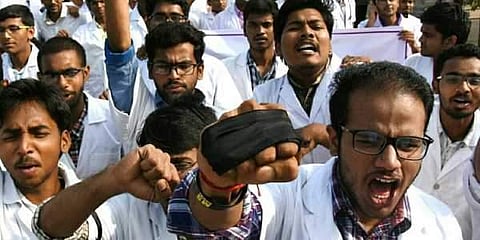

NEW DELHI: A recent incident of violence between a resident doctor and patient’s keen which happened in Nil Ratan Sarkar (NRS) Medical College and Hospital in Kolkata nearly brought the healthcare system in the country to a halt. Resident doctors from across all states withdrew their services and the act was supported by senior faculty members.
This was, however, not the first time. In India, physical assault on doctors and medical or paramedical staff by the kin of patients is almost a routine affair. And, the latest study — ‘Healthcare in India and Violence against Doctors: The missing links’ — conducted by a senior professor at the All India Institute of Medical Sciences (AIIMS), Delhi and published in the Indian Journal of Nephrology —brings out why this is a common phenomenon in the country.
Patients’ attendants
The study highlights that though in the majority of public hospitals, the number of patients’ attendants is restricted as per policy, it is grossly violated.
“The attendants are required for arranging medicines at emergency as well as on routine basis. They are also entrusted with various patient-related work, ranging from biological sample delivery to laboratory, collection of reports, shifting of patients for various tests and wheeling the patient on the trolley, among others,” Dr Sanjay Agarwal, author of the study and professor and head, Nephrology, AIIMS, Delhi.
Overcrowding
The study suggests that in most public hospitals there are no adequate sitting arrangements and neither are there any air conditioners in such crowded places. “In such a situation, standing for hours is difficult for a sick patient or his attendant. And any lack of communication or delay on the part of the hospital management is likely to trigger an outburst by the patients. And more often than not, doctors and the nursing staff bear the brunt of it,” the study noted.
Emergency beds
In most public hospitals in the country, emergency beds are limited. Hospitals are often forced to make do with trolleys as regular beds and decrease the basic necessity of space requirement between two beds, thus increasing the risk of cross-infection.
“Most cases of violence take place in emergency wards.
“The infrastructure in any government-run hospital is still not up to the mark. There aren’t as many beds as required in emergency wards and if a patient collapses, the attendant’s first target is the resident doctor or doctors in the ward, who are mostly junior in the profession. They bear the brunt of such attacks,” Gupta said.
Patients’ educational background
Most patients visiting public hospitals are not only poor but their academic background are no match to those crowding the corridors of private hospitals.“It is difficult to give them a detailed explanation of diseases, potential treatment and the outcome. After a time, the final word ‘doctor you do what you think is best for me’ is the usual attitude. It very unusual to find patients’ kin at government hospitals being involved in the discussions or decisions the course of treatment,” the study noted.
Resident doctors’ responsibility
Today’s resident doctors often lack communication skill and the way they communicate with the patients and their attendants, particularly when the patient is sick, often becomes the trigger for an altercation with patients’ attendants.“There is nothing in the medical curriculum about communication skill. It mostly comes with experience. However, since that experience is lacking in many resident doctors, they become the most common target whenever an argument or a scuffle ensues with patients’ relatives,” the study said.
Lack of infrastructure
Dr Sambashiva Rao, former director of health and medical department, Telangana, told this newspaper that government has not invested sufficient amount of money in providing required life-care in public healthcare units.“If patient needs ventilation but the hospital doesn’t have it, where and how will the doctor on duty secure one? During an emergency, one cannot expect attendants to understand the circumstances,” he added.
“Incidents of violence are an indication that our healthcare system has major flaws, which includes under-funded and inadequate under human resource. Lack of infrastructure is an issue, but the problem lies much deeper than that,” Anant Bhan, a health expert, said.
Strike a solution?
Harjit Bhatti, senior resident doctor, AIIMS said that in India, protest is the only way to get attention of the government as there is no other way to convey a message to lawmakers. “Unless any extreme step is taken, there is no sympathy from the government for our cause. Strike is no luxury for us. We don’t want bouncers to beat patients. We just want more security especially during incidents of violence,” he added.